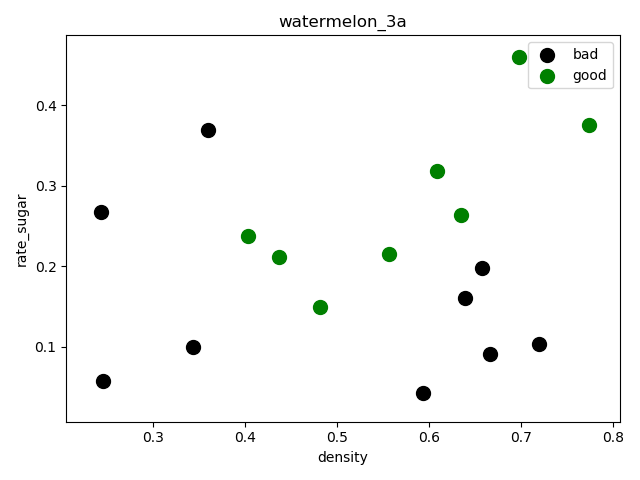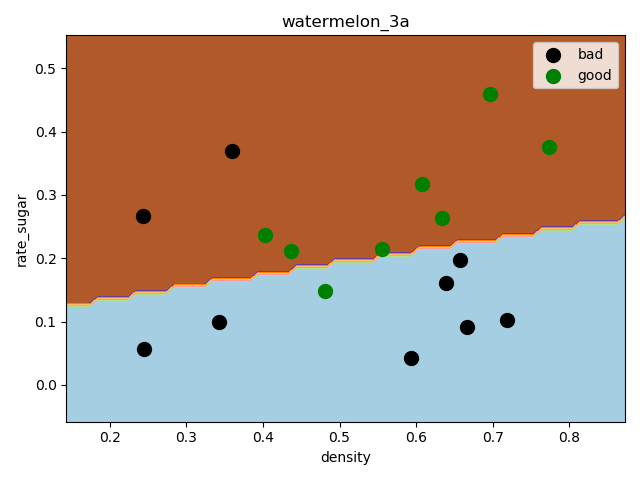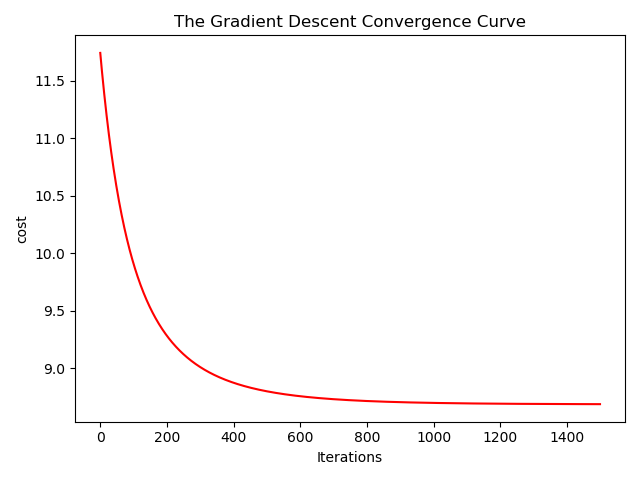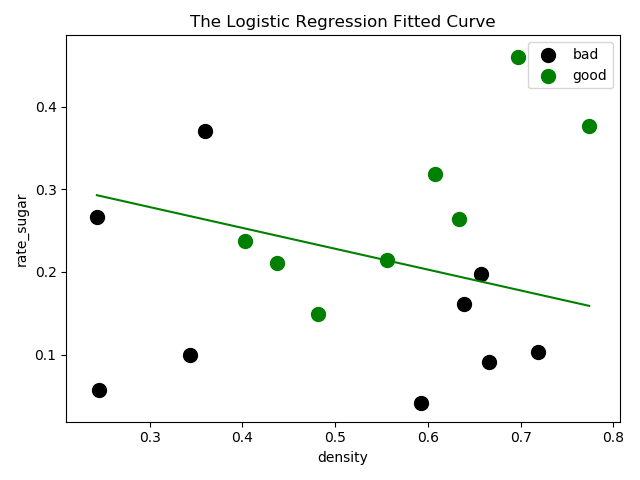参考:https://www.cnblogs.com/judejie/p/8999832.html https://blog.csdn.net/zouxy09/article/details/20319673 https://blog.csdn.net/Snoopy_Yuan/article/details/63684219?utm_medium=distribute.pc_relevant.none-task-blog-BlogCommendFromMachineLearnPai2-2.nonecase&depth_1-utm_source=distribute.pc_relevant.none-task-blog-BlogCommendFromMachineLearnPai2-2.nonecase
完整代码:https://github.com/happybear1234/The-Watermelon-book-exercises/blob/master/Practical_3.3/code/Practical_3.3.py https://github.com/happybear1234/The-Watermelon-book-exercises/blob/master/Practical_3.3/code/Practical_3.3_self_def.py
习题3.3 编程实现对率回归,并给出西瓜数据集(如下)上的结果.
密度
含糖率
好瓜
0.697
0.46
是
0.774
0.376
是
0.634
0.264
是
0.608
0.318
是
0.556
0.215
是
0.403
0.237
是
0.481
0.149
是
0.437
0.211
是
0.666
0.091
否
0.243
0.267
否
0.245
0.057
否
0.343
0.099
否
0.639
0.161
否
0.657
0.198
否
0.36
0.37
否
0.593
0.042
否
0.719
0.103
否
因此将以上数据中好瓜表示为”1”,不好的瓜表示为”0”,转换成csv文件便于读取
公式说明 基础线性模型:
该函数为连续可导凸函数(对应海塞矩阵正定),因此可用梯度下降求得最优解,梯度为:
sklearn库实现 载入数据,预处理 1 2 3 4 5 6 7 8 9 import numpy as np import matplotlib.pyplot as plt dataset = np.loadtxt('/home/data/watermelon_3a.csv', delimiter=',') X = dataset[:, 1 : 3] y = dataset[:, 3] print(np.shape(X))
(17, 2)绘制分散图,查看数据分散情况:
1 2 3 4 5 6 7 8 f1 = plt.figure(1) plt.title('watermelon_3a') plt.xlabel('density') plt.ylabel('rate_sugar') plt.scatter(X[y == 0, 0], X[y == 0, 1], marker = 'o', color = 'k', s = 100, label= 'bad') plt.scatter(X[y == 1, 0], X[y ==1, 1], marker= 'o', color = 'g', s = 100, label = 'good') plt.legend(loc = 'upper right') plt.show()
sklearn逻辑回归库拟合 调用sklearn中的逻辑回归模型进行训练和预测
1 2 3 4 5 6 7 8 9 10 11 12 13 14 from sklearn import model_selection from sklearn.linear_model import LogisticRegression from sklearn import metrics import matplotlib.pylab as pl # 切分数据集:留出法 返回 划分好的训练集测试集样本和训练集测试集标签 X_train, X_test, y_train, y_test = model_selection.train_test_split(X, y, test_size=0.5, random_state=0) # 训练模型 log_model = LogisticRegression() log_model.fit(X_train, y_train) # 模型测试 y_pred = log_model.predict(X_test)
打印混淆矩阵和相关度量,结果如下:
1 2 3 print(metrics.confusion_matrix(y_test, y_pred)) print(metrics.classification_report(y_test, y_pred)) precision, recall, thresholds = metrics.precision_recall_curve(y_test, y_pred)
[[3 2]
[1 3]]
precision recall f1-score support
0.0 0.75 0.60 0.67 5
1.0 0.60 0.75 0.67 4
accuracy 0.67 9
macro avg 0.68 0.68 0.67 9
weighted avg 0.68 0.67 0.67 9这里选择的留出法抽取样本,因为样本比较少,拟合效果一般,预测精度只有67%,可以采用自助法或者交叉验证法重新抽样,进一步选择最优模型
绘制决策边界 1 2 3 4 5 6 7 8 9 10 11 12 13 14 15 16 17 18 f2 = plt.figure(2) h = 0.01 x0_min, x0_max = X[:, 0].min() - 0.1, X[:, 0].max() + 0.1 x1_min, x1_max = X[:, 1].min() - 0.1, X[:, 1].max() +0.1 x0, x1= np.meshgrid(np.arange(x0_min, x0_max, h), np.arange(x1_min, x1_max, h)) # 生成笛卡尔积坐标矩阵 z = log_model.predict(np.c_[x0.ravel(), x1.ravel()]) # c_ 按列合并, ravel 降成一维 z = z.reshape(x0.shape) plt.contourf(x0, x1, z, cmap = pl.cm.Paired)# 等高线 plt.title('watermelon_3a') plt.xlabel('density') plt.ylabel('rate_sugar') plt.scatter(X[y==0, 0], X[y==0, 1], marker='o', color='k', s=100, label='bad') plt.scatter(X[y==1, 0], X[y==1, 1], marker='o', color='g', s=100, label='good') plt.legend(loc='upper right') plt.show()
梯度下降法实现 实现以上公式 1 2 3 4 5 6 7 8 9 10 11 12 13 14 15 16 17 18 19 20 21 22 23 24 25 26 27 28 29 30 31 32 33 34 35 36 37 38 39 40 41 42 43 44 45 46 47 48 49 50 51 52 # 1)实现 P59 公式3.27极大似然法 def likelihood_sub(x, y, beta): """ :param x: 一个示例变量(行向量) :param y:一个样品标签(行向量) :param beta:3.27中矢量参数(行向量) :return: 单个对数似然 3.27 """ return -y * np.dot(beta, x.T) + np.math.log(1 + np.math.exp(np.dot(beta, x.T))) def likelihood(X, y, beta): """ 公式 3.27 :对数似然函数(交叉熵损失函数) :param X: 示例变量矩阵 :param y:样本标签矩阵 :param beta:3.27中的矢量参数 :return: beta 的似然值 """ sum = 0 m, n = np.shape(X) for i in range(m): sum += likelihood_sub(X[i], y[i], beta) return sum # 2)实现似然公式一阶偏导 def sigmoid(x, beta): """ 基础模型 S 形函数 P59 对数几率回归(逻辑回归)公式 3.23 :param x: 预测变量 :param beta: beta 变量 :return:S 形函数 """ return 1 / (1 + np.math.exp(- np.dot(beta, x.T))) def partial_derivative(X, y, beta): """ P60 似然公式一阶偏导3.30 :param X:示例变量矩阵 :param y:样本标签矩阵 :param beta:3.27 中矢量参数 :return: beta 的偏导数,梯度 """ m, n = np.shape(X) pd = np.zeros(n) for i in range(m): tmp = -y[i] + sigmoid(X[i], beta) for j in range(n): pd[j] += X[i][j] * tmp return pd
这里采用批量梯度下降法:
1 2 3 4 5 6 7 8 9 10 11 12 13 14 15 16 def gradDscent(X, y, alpha, iterations, n): """ :param X:变量矩阵 :param y:样本标签数组 :return:3.27中beta参数最优解 """ cost = np.zeros(iterations) # 构建 max_times 个 0 的数组 beta = np.mat(np.zeros(n)) # 初始化 beta for i in range(iterations): # 梯度下降 output = partial_derivative(X, y, beta) beta = beta - alpha * output cost[i] = likelihood(X, y, beta) return beta, cost
绘制收敛曲线 1 2 3 4 5 6 7 8 9 10 11 12 13 14 def showConvergCurve(Iterations, Cost): """ :param Iterations: 迭代次数 :param Cost: 损失值数组 """ f1 = plt.figure(1) t = np.arange(Iterations) p1 = plt.subplot(1,1,1) p1.plot(t, Cost, 'r') p1.set_xlabel('Iterations') p1.set_ylabel('cost') p1.set_title('The Gradient Descent Convergence Curve') plt.show()
这里步长取得0.1,迭代次数1500,在800次迭代后趋于稳定
绘制决策边界 1 2 3 4 5 6 7 8 9 10 11 12 13 14 15 16 17 def showLogRegression(X, y, Beta, N): f2 = plt.figure(2) plt.title('The Logistic Regression Fitted Curve') plt.xlabel('density') plt.ylabel('rate_sugar') # f = Beta * X.transpose() # plt.plot(X[:, 2], f.tolist()[0], 'r', label = 'Prediction') min_x = min(X[:, 0]) max_x = max(X[:, 0]) y_min_x = (- Beta.tolist()[0][2] - Beta.tolist()[0][0] * min_x) / Beta.tolist()[0][1] # 由线性模型 y = w1 * x1 + w2 * x2 +b y_max_x = (- Beta.tolist()[0][2] - Beta.tolist()[0][0] * max_x) / Beta.tolist()[0][1] plt.plot([min_x, max_x], [y_min_x, y_max_x], '-g') plt.scatter(X[y == 0, 0], X[y == 0, 1], marker='o', color='k', s=100, label='bad') plt.scatter(X[y == 1, 0], X[y == 1, 1], marker='o', color='g', s=100, label='good') plt.legend(loc='upper right') plt.show()
测试 1 2 3 4 5 6 7 8 9 10 11 12 13 14 15 16 17 18 19 20 21 22 23 24 25 26 27 28 29 30 31 32 def testLogRegres(Beta, test_x, test_y): m, n = np.shape(test_x) matchCount = 0 for i in range(m): predict = sigmoid(test_x[i], Beta) > 0.5 if predict == bool(test_y[i]): matchCount += 1 accuracy = float(matchCount) / m return accuracy def loadData(): dataset = np.loadtxt('/home/data/watermelon_3a.csv', delimiter=',') X = dataset[:, 1: 3] tmp = np.ones(X.shape[0]) X = np.insert(X, 2, values=tmp, axis=1) # 在最后一列插入全是 1 的列 y = dataset[:, 3] return X, y def main(): alpha = 0.1 # 迭代步长 iterations = 1500 # 迭代次数上限 X, y = loadData() test_x = X test_y = y m, n = np.shape(X) beta, cost = gradDscent(X, y, alpha, iterations, n) print(beta) showConvergCurve(iterations, cost) showLogRegression(X, y, beta, n) accuracy = testLogRegres(beta, test_x, test_y) print('The classify accuracy is: %.3f%%' %(accuracy * 100))
The classify accuracy is: 70.588%



